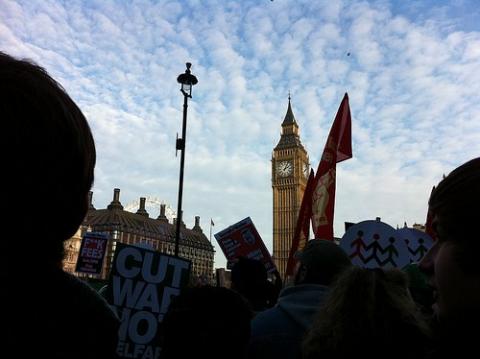Where next? A British perspective

With a stronger Labour tradition and a stronger right-wing tradition, there are many lessons to be learned from our nearest geographical neighbours. Today, with a conservative leadership and a vibrant student resistance movement, Ceasefire’s Omayr Rehmaan Ghani gives us a valuable British perspective on the limitations and possibilities that may lie ahead.
'It’s the closest thing we might get to a national unity government,’ said Labour leader Eamon Gilmore on RTÉ this weekend; it could just as accurately be described as the worst of both worlds. The long-inevitable coalition between Fine Gael and Labour (an unbroken constant for the 17 of the past 78 years when Fianna Fáil hasn’t been in power) will ensure a government with a right wing ideological backbone with the tacit support of the soft ‘left’. To put it another way, a conservative-led government in Ireland will have it easy for precisely the same reason as one is struggling in Britain.
In being confined to the opposition benches without a sense of leadership or direction the British Labour Party has seen many of its best activists, trade union affiliates and sympathisers in the liberal press now not only criticise government policy more harshly but also criticise the very economic system that leads to such policy in the first place. Indeed pace at which some commentators went from years of arguing for minor reforms within an extremely narrow framework to the conclusion that the framework itself is ‘a semi-criminal money-laundering economy’ has at times been dizzying.
Thus in Ireland, where the Labour party has many of the same affiliates, such as Unite and the GMB and RMT unions, we can expect to see a movement in the other direction; as we see the organisation of animosities (the key function of political parties) realign themselves back in the system’s favour.
Whilst this trend is likely to affect student politics, that is not to say the new coalition in Ireland will be immune from the other main reason the British conservative government is struggling against the will of the people - the founding of an independent, decentralised student movement. The National Campaign Against Fees and Cuts (NCAFC) has managed to mobilise students in their hundreds of thousands in a way the National Union of Students (the USI’s equivalent) has been unable, or more likely, unwilling to do. It has managed to do so by relying on non-hierarchical structures that on both a micro and macro level have managed to outwit the security forces and establishment. It has recently inspired an Irish counterpart called Free Education for Everyone that could prove itself potent if and when the student movement, which kicked off in Ireland before it did so in Britain, reasserts itself. The similarly structured UK Uncut, which occupies commercial outlets of companies that owe billions to the public in unpaid tax, has also found a counterpart in the Cork-based ‘Social Welfare Defenders’ who occupied an Anglo-Irish bank in November and have since successfully coordinated actions with the student movement and broader left in ways that could well form the blueprint for a much larger, possibly triumphant struggle.
The success of Sinn Féin (more than trebling its seats from 4 to 14 and earning it full speaking rights in the Dáil) and the newly-formed United Left Alliance (winning 5 seats with the prospect of forming a ‘Technical Group’ with other independents to earn the same privilege) in the recent elections opens up the prospect of thriving extra-parliamentary activism being complemented by political support within parliament itself. Such support, while vital if the two parties are to capitalise on disaffection with the governing coalition as its austerity package coupled with rising fuel prices sting its own electorate, cannot be assumed as the increased electoral success of radical parties also makes the contradictions of working within a system you are trying to ultimately dispense with more apparent, more often than not leading to a sacrifice of the latter goal in favour of continuing with the former.
On the flip-side of the rise in support for Fine Gael, Labour, Sinn Féin, the ULA and Independents (of which Ireland continues to have the highest proportion in the world due to a unique voting system and an elected representative-to-citizen ratio four times higher than in Britain) is the collapse (from 77 TDs in the 2007 general election to just 20 in last week’s) of Fianna Fáil and the wipe-out of its coalition partner the Green Party. Though the collapse of Ireland’s natural party of government is historic on a national level it is simply another confirmation of a continuing continental trend for centre-right political parties. Germany’s Christian Democratic Union secured 47.2% of the national vote in the Hamburg State Elections in 2008 yet achieved just 21.9% in the same election last month (a gulf larger than Fianna Fáil’s drop from 41.6% to 17.4% of First Preference votes). The trend is likely to be followed in France - where President Sarkozy won the 2007 presidential election with 53% and now trails in the polls at 25% with elections due early next year at the latest - Italy and very possibly the UK before coming back to hit Ireland’s second right wing party.
Although this is due in a large part to crises in the currency markets that are exacerbated with the fall of each government who serves them, successful organisation and coordination of our increasingly clear opposition to the neoliberal agenda beyond the electoral sphere will not only keep these governments at bay for the longer term but will also guarantee that the question of where next is left to the people and not the market.
Image top via merkowaty on Flickr.
